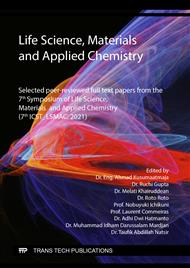[1]
M.M. Buckley, R.N. Brogden, Ketorolac. A review of its pharmacodynamic and pharmacokinetic properties, and therapeutic potential, Drugs. 39 (1) (1990) 86–109.
DOI: 10.2165/00003495-199039010-00008
Google Scholar
[2]
E. Mroszczak, D. Combs, M. Chaplin, I. Tsina, T. Tarnowski, C. Rocha, Y. Tam, A. Boyd, J. Young, L. Depass, Chiral kinetic and dinamics of ketorolac, J. Clin. Pharmacol. 36 (6) (1996) 521- 539.
DOI: 10.1002/j.1552-4604.1996.tb05042.x
Google Scholar
[3]
K.R. Ing-Lorenzini, J.A. Desmeules, M. Bessona, J. Veuthey, P. Dayer, Y. Daali, Two-dimensional liquid chromatography–ion trap mass spectrometry for the simultaneous determination of ketorolac enantiomers and paracetamol in human plasma: application to a pharmacokinetic study, J. Chromatogr. A. 1216 (18) (2009) 3851–3856.
DOI: 10.1016/j.chroma.2009.02.071
Google Scholar
[4]
B.L. Strom, J.A. Berlin, J.L. Kinman, P.W. Spitz, S. Hennessy, H. Feldman, S. Kimmel, J.L. Carson, Parenteral ketorolac and risk of gastrointestinal and operative site bleeding. A postmarketing surveillance study, JAMA. 275 (5) (1996) 376–382.
DOI: 10.1097/00132586-199702000-00029
Google Scholar
[5]
M. Singh, R. Bhushan, Thin-layer chromatographic enantioresolution of (RS)-ketorolac using L-amino acids as chiral additive in stationary phase, J. Planar Chromat. 32 (6) (2019) 475–479.
DOI: 10.1556/1006.2019.32.6.5
Google Scholar
[6]
Y. He, Y. Wu, L. Cheng, S. He, Q. Wang, H. Wang, Y. Ke, Separation of ketorolac enantiomers on polysaccharide-based chiral stationary phases using a polar organic mobile phase, Sep. Sci. Plus. 1 (2018) 351–358.
DOI: 10.1002/sscp.201800048
Google Scholar
[7]
M. Pérez-Venegas, A.M. Rodríguez-Treviño, E. Juaristi, Dual mechanoenzymatic kinetic resolution of (±)-ketorolac, ChemCatChem. 12 (6) (2020) 1782–1788.
DOI: 10.1002/cctc.201902292
Google Scholar
[8]
K.S. Dubey, J. Hemantha, C.K. Venkatesh K., R.N. Saha, S. Pasha, New chiral reverse phase HPLC method for enantioselective analysis of ketorolac using chiral AGP column, J. Pharm. Anal. 2 (6) (2012) 462–465.
DOI: 10.1016/j.jpha.2012.07.006
Google Scholar
[9]
Hidayah, Validation of the analysis method of ketorolac chiral compound from pharmaceutical preparation using HPLC method, Skripsi, (2020).
Google Scholar
[10]
E.S. Nurhidayah, A.L. Ivansyah, M.A. Martoprawiro, M.A. Zulfikar, A molecular docking study to predict enantioseparation of some chiral carboxylic acid derivatives by methyl-β- cyclodextrin, J. Phys. Conf. Ser. 1013 (1) (2018) 012203.
DOI: 10.1088/1742-6596/1013/1/012203
Google Scholar
[11]
G. Fernández-Ballester, A. Fernández-Carvajal, J.M. González-Ros, A. Ferrer-Montiel, Ionic channels as targets for drug design: a review on computational methods, Pharmaceutics. 3 (4) (2011) 932–953.
DOI: 10.3390/pharmaceutics3040932
Google Scholar
[12]
S. Bua, L.D.C. Mannelli, D. Vullo, C. Ghelardini, G. Bartolucci, A. Scozzafava, C.T. Supuran, F. Carta, Design and synthesis of novel nonsteroidal anti-inflammatory drugs and carbonic anhydrase inhibitors hybrids (NSAIDs-CAIs) for the treatment of rheumatoid arthritis, J. Med. Chem. 60 (3) (2017) 1159–1170.
DOI: 10.1021/acs.jmedchem.6b01607
Google Scholar
[13]
K. Mena-Ulecia, W. Tiznado, J. Caballero, Study of the differential activity of thrombin inhibitors using docking, QSAR, molecular dynamics, and MM-GBSA, PloS One. 10 (11) (2015) e0142774.
DOI: 10.1371/journal.pone.0142774
Google Scholar
[14]
B. Amul, S. Muthu, M. Raja, S. Sevvanthi, Molecular structure, spectroscopic (FT-IR, FT-Raman, NMR, UV-VIS), chemical reactivity and biological examinations of Ketorolac, Journal of Molecular Structure. 1210 (2020) 128040.
DOI: 10.1016/j.molstruc.2020.128040
Google Scholar
[15]
L.D.C. Mannelli, D. Bani, A. Bencini, M.L. Brandi, L. Calosi, M. Cantore, A.M. Carossino, C. Ghelardini, B. Valtancoli, P. Failli, Therapeutic effects of the superoxide dismutase mimetic compound MnIIMe2DO2A on experimental articular pain in rats, Mediat. Inflamm. (2013) 905360.
DOI: 10.1155/2013/905360
Google Scholar
[16]
A. Barakat, H.J. Al-Najjar, A.M. Al-Majid, S.M. Soliman, Y.N. Mabkhot, M.R. Shaik, H.A. Ghabbour, H. Fun, Synthesis, NMR, FT-IR, X-ray structural characterization, DFT analysis and isomerism aspects of 5-(2,6-dichlorobenzylidene)pyrimidine-2,4,6(1H,3H,5H)-trione, Spectrochim. Acta A Mol. Biomol. Spectrosc. 147 (2015) 107–116.
DOI: 10.1016/j.saa.2015.03.016
Google Scholar
[17]
N.F. Roslan, S.F.Z. Mustafa, H. Maarof, S.N.Md. Ajeman, W.A.W Ibrahim, Molecular docking and density functional theory calculations of vinpocetine and teicoplanin aglycone chiral selector, J. Incl. Phenom. Macrocycl. Chem. 98 (2020) 187–195.
DOI: 10.1007/s10847-020-01015-9
Google Scholar
[18]
S.S.W. Waskitha, F.E. Mulyana, N.F. Riza, Y.M. Stansyah, I. Tahir, T.D. Wahyuningsih, QSAR Approach and synthesis of chalcone derivatives as antimalarial compound against Plasmodium Falciparum 3D7 Strain, Rasayan J. Chem. 14 (2021) 2363–2370.
DOI: 10.31788/rjc.2021.1445867
Google Scholar
[19]
T. Lengauer, M.Rarey, Computational methods for biomolecular docking, Curr. Opin. Struct. Biol. 6 (3) (1996) 402–406.
Google Scholar



